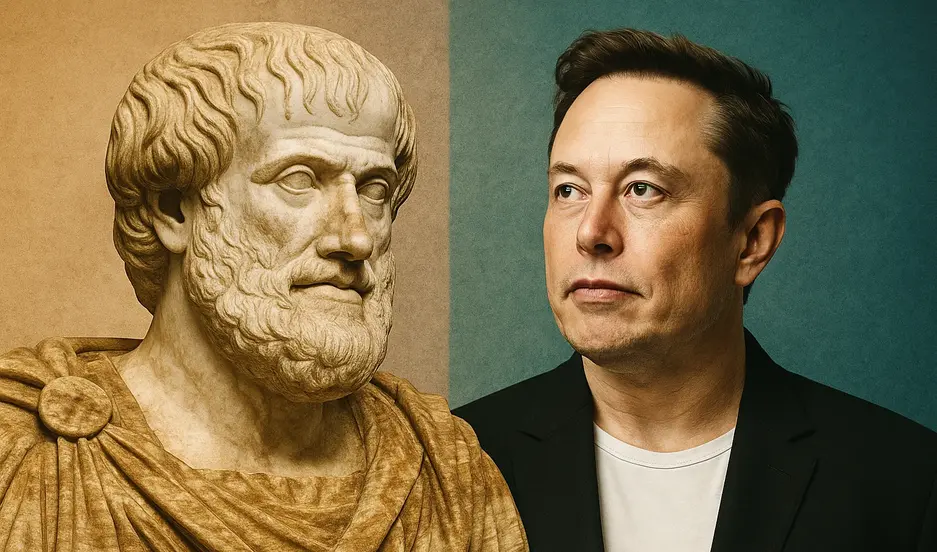What if everything you’ve been taught about solving problems is wrong? That’s the premise behind first principles thinking—a method that strips away assumptions and rebuilds solutions from the ground up. Once the domain of philosophers, the concept is now fueling some of the most transformative innovations in aerospace, electric vehicles, and artificial intelligence.
Industry leaders like Elon Musk and companies such as SpaceX and Tesla have used this framework to defy conventional wisdom, driving down costs and accelerating technological breakthroughs. Increasingly, experts argue that first principles thinking isn’t just a Silicon Valley buzzword—it’s a competitive edge anyone can learn.
The Roots of a Radical Idea
The concept of first principles traces back to Aristotle. The ancient Greek philosopher argued that to truly understand something, one must reduce it to its most basic, undeniable truths and reason upward from there.
Think of it like Lego bricks. Reasoning by analogy is like copying someone else’s Lego spaceship with minor tweaks. Reasoning from first principles is dismantling that spaceship, laying the bricks on the table, and asking: What can I build from these pieces? The result could be something entirely unexpected—perhaps a robot, a bridge, or a design no one has ever imagined.
This mindset moves beyond “how it’s always been done” to focus on what must be true. In industries where inertia often slows change, that can be transformative.
SpaceX and the Rocket Cost Revolution
When Elon Musk set out to build rockets in the early 2000s, experts dismissed his ambitions as unrealistic. The cost of building launch vehicles was astronomical, and industry insiders insisted that was simply the way things worked.
Instead of accepting conventional wisdom, Musk asked a different question: What is a rocket actually made of? Breaking it down to raw components—aluminum, titanium, copper, and carbon fiber—he calculated that materials made up only about 2% of the final rocket price.
The rest, Musk concluded, was tradition, inefficiency, and markup. By starting from first principles, SpaceX redesigned rockets to be reusable and dramatically less expensive. What once seemed impossible is now routine: cutting launch costs by orders of magnitude and reshaping the global space industry.
Reinventing Batteries at Tesla
The same logic guided Musk at Tesla. A decade ago, the prevailing belief was that battery costs would always make electric cars uncompetitive. Analysts repeated the mantra: “Batteries are just too expensive.”
But by asking what batteries were really made of—nickel, cobalt, aluminum, polymers—Tesla engineers found new ways to reduce costs through design and scale. That rethinking helped transform electric vehicles from a niche luxury into a mainstream market.
Beyond Rockets and Cars: AI and Business Models
First principles thinking isn’t confined to hardware. In artificial intelligence, researchers abandoned rule-based systems after decades of stagnation. By questioning assumptions, they developed neural networks and later transformers—the foundation of today’s generative AI.
The approach has reshaped business models, too. Amazon asked, “Do we need inventory at all?” and pioneered drop-shipping and cloud-based infrastructure. Netflix asked, “What if movies didn’t require DVDs?” and reinvented global entertainment.
Each breakthrough started not with tweaking existing systems, but with stripping them down to fundamentals.
Hire Innovators Who Think in First Principles
Just as AI and business pioneers reshaped industries by questioning assumptions, your company can grow with talent that challenges the status quo. Post your job on WhatJobs and find future-ready thinkers.
Post a Job Now →The Mechanics: How to Apply First Principles Thinking
Experts suggest practical tools to apply this way of reasoning:
- The Five Whys Method
Ask “why” five times in succession. For example:- Why is my software build slow?
- Because the pipeline is bloated.
- Why? Because it loads redundant dependencies.
- Why? Because the library management hasn’t been updated.
This process exposes the root cause rather than surface symptoms.
- Critical Questioning
Challenge assumptions directly:- What do we know for sure?
- What if the opposite were true?
- What evidence supports this?
- Decomposition and Recombination
Break a problem into its smallest parts, then recombine them in unexpected ways. Imagine a tank, a motorbike, and a bicycle. By analogy, you’d improve each machine separately. By first principles, you might combine treads, motors, and handlebars into an entirely new invention—a snowmobile. - Step-by-Step Plan
- Identify assumptions
- Break them down into fundamental truths
- Rebuild from scratch
- Test, iterate, and refine
Why It Matters in Today’s Economy
In fast-moving industries, reasoning by analogy feels safe. It copies proven models and makes incremental improvements. But in a global economy defined by disruption from tariffs to AI-driven job automation incremental change may not be enough.
At SpaceX, employees are trained to ignore standard practices and start fresh. The result: faster design cycles than NASA, despite a fraction of the budget. In business, companies that reframe problems often unlock new growth opportunities.
Importantly, individuals can use the same skill. Entrepreneurs questioning whether they need an office might realize the fundamental goal is simply serving customers leading to remote-first startups with lower overhead. Students preparing for interviews can break down problems into core truths rather than memorizing canned answers.
The Competitive Edge
First principles thinking is more than a clever mental trick. It is, as analysts put it, “structured creativity.” It allows innovators to leap from marginal improvements to paradigm shifts.
Tesla’s batteries, SpaceX’s rockets, Amazon’s cloud model, and the AI systems transforming entire industries—each owes its success to peeling back assumptions and rethinking fundamentals.
As global competition intensifies, the companies and individuals who adopt this mindset may not just improve existing systems. They may redefine them entirely.
FAQs About First Principles Thinking
1. What exactly is first principles thinking?
First principles thinking is a problem-solving framework that breaks complex issues into their most basic truths. Instead of copying existing solutions, you rebuild from the ground up, often discovering new and more efficient answers.
2. How is first principles thinking different from reasoning by analogy?
Reasoning by analogy improves on existing models. First principles thinking ignores tradition, questions assumptions, and reimagines solutions. Where analogy tweaks, first principles transforms.
3. Can anyone use first principles thinking, or is it just for tech leaders?
Anyone can practice it. While high-profile examples come from Elon Musk or companies like SpaceX, individuals can use first principles thinking in careers, business ideas, or even daily problem-solving.
4. What practical steps can I take to apply first principles thinking?
Start by listing your assumptions, break them down to undeniable truths, rebuild solutions from scratch, and test them. Using tools like the “Five Whys” method or critical questioning makes the process manageable.




